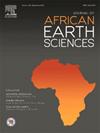Kerman省南部faryab变质岩系斜长辉石岩成因及地球动力学伊朗南部地幔非均质性证据
IF 2.2
4区 地球科学
Q2 GEOSCIENCES, MULTIDISCIPLINARY
引用次数: 0
摘要
位于伊朗克尔曼省东南部具有古生代的Faryab超镁质杂岩。野外证据表明,它是由巴干变质岩单元变质后侵位在巴干变质杂岩中,包括辉石、辉橄榄岩、泥质、斜辉石岩和铬铁矿。斜辉石岩以脉脉和脉脉的形式侵入橄榄岩,其堆积结构表明橄榄岩是由硅酸盐熔体结晶而成。矿物化学表明它们的成因为地幔(Cpx的mg# = 91 ~ 94),它们的整体岩石组成与morb和地幔贫橄榄岩(Ni高达720 ppm, MgO = 32.4 wt%)不相似;然而,它们在LILE和LREE中被耗尽,而与众所周知的斜磷灰石堆积物相似。法里亚斜辉石全岩化学成分(SiO2 = 50.67, Cr = 6180 ppm)表明母岩浆可能为低钙硼质熔体。这些博长岩是由原生富钙苦橄熔体与主橄榄岩反应形成的,当它们穿过破碎的岩石圈橄榄岩上升时,留下了Faryab斜长橄榄岩。斜长石质岩的平行交替表明,该地区上地幔可能发生了底顶上升,导致上地幔压力降低和部分熔融,形成了岩石圈平行裂缝。Faryab斜长石岩可以认为是新特提斯岩石圈超俯冲带熔体上升并形成相对高压堆积的通道。斜辉石岩的存在及其成岩演化为伊朗南部上地幔非均质性提供了不可否认的证据。本文章由计算机程序翻译,如有差异,请以英文原文为准。

Petrogenesis and geodynamics of clinopyroxenites in faryab metaultramafic sequence (south of Kerman province); Evidences for mantle heterogeneity in southern Iran
The Faryab ultramafic complex with Paleozoic age, located in the south east of Kerman province, Iran. Field evidences show that it has emplaced in the Bajgan metamorphic complex after metamorphosing the Bajgan units, and includes harzburgite, lherzolite, dunite, clinopyroxenite, and chromitite. Clinopyroxenite has intruded into the peridotites in the form of dykes and veins and their cumulate texture, indicate that these rocks have crystallized from silicate melts. Mineral chemistry reveals a mantle origin for them (Mg# of Cpx = 91–94) and their whole rock composition is not similar to MORBs and mantle-depleted peridotites (Ni up to 720 ppm and MgO = 32.4 wt%); however, they are depleted in LILE and LREE compared to HREE similar to well-known clinopyroxen asite cumulates. The whole rock chemical composition of Faryab clinopyroxenits (SiO2 = 50.67 and Cr = 6180 ppm) suggests that the parent magmas were probably Low-Ca boninitic melts. These boninites derived from the reaction between primary calcium rich picritic melts and the host peridotites and as they ascend through fractured lithospheric peridotites, leaving behind the Faryab clinopyroxenites. The parallel alternating of clinopyroxenites suggest that the upper mantle in this region likely rose diapirically, causing pressure reduction and partial melting of the upper mantle and resulted in the formation of parallel fractures in the lithosphere. The Faryab clinopyroxenites can be considered as channels through which the supra-subduction zone melts of the Neotethys lithosphere ascended and formed them as relatively high pressure cumulates. The presence of clinopyroxenites and their petrogenetic evolution provide undeniable evidence of upper mantle heterogeneity in south of Iran.
求助全文
通过发布文献求助,成功后即可免费获取论文全文。
去求助
来源期刊

Journal of African Earth Sciences
地学-地球科学综合
CiteScore
4.70
自引率
4.30%
发文量
240
审稿时长
12 months
期刊介绍:
The Journal of African Earth Sciences sees itself as the prime geological journal for all aspects of the Earth Sciences about the African plate. Papers dealing with peripheral areas are welcome if they demonstrate a tight link with Africa.
The Journal publishes high quality, peer-reviewed scientific papers. It is devoted primarily to research papers but short communications relating to new developments of broad interest, reviews and book reviews will also be considered. Papers must have international appeal and should present work of more regional than local significance and dealing with well identified and justified scientific questions. Specialised technical papers, analytical or exploration reports must be avoided. Papers on applied geology should preferably be linked to such core disciplines and must be addressed to a more general geoscientific audience.
 求助内容:
求助内容: 应助结果提醒方式:
应助结果提醒方式:


